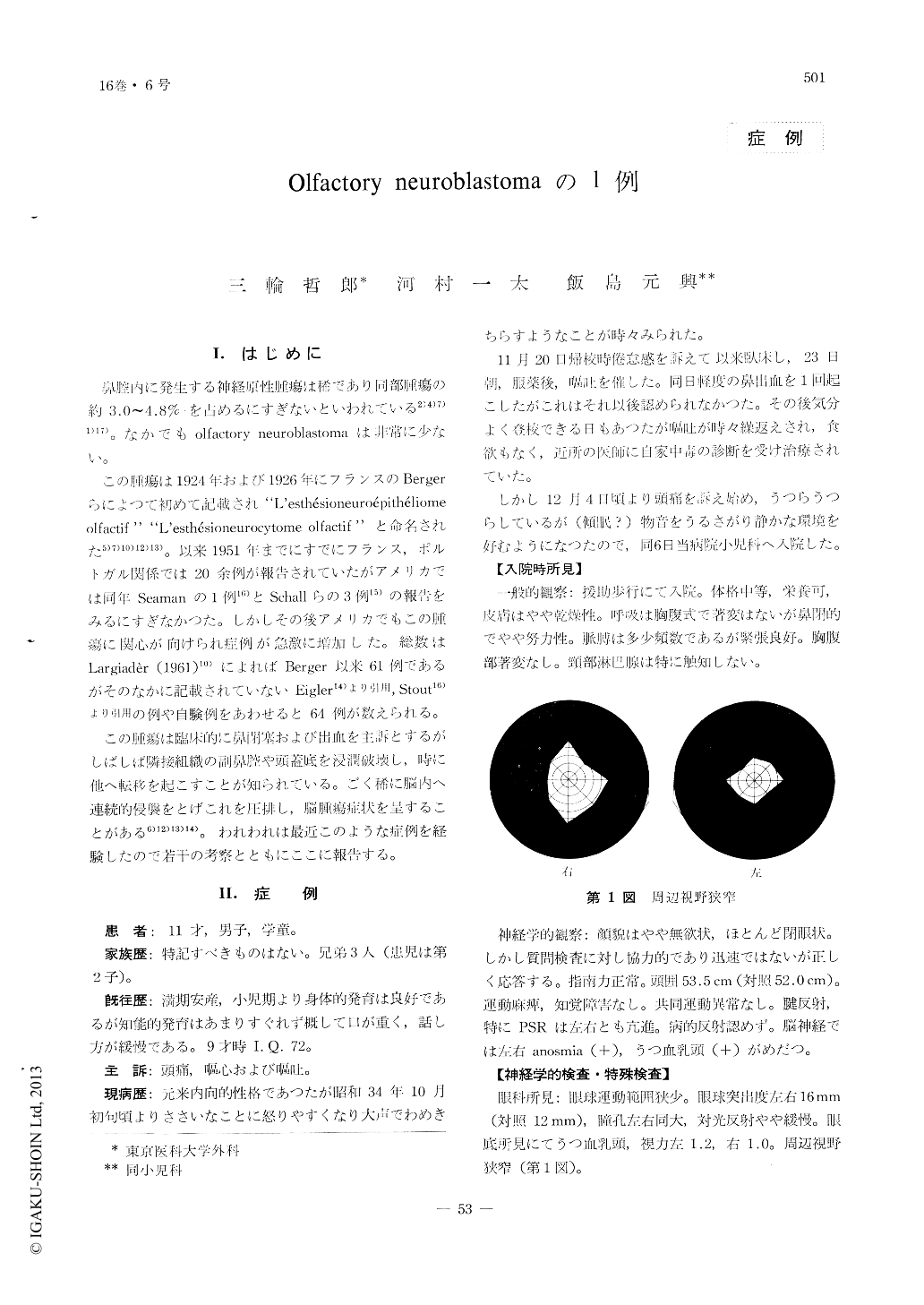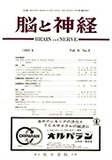Japanese
English
- 有料閲覧
- Abstract 文献概要
- 1ページ目 Look Inside
I.はじめに
鼻腔内に発生する神経原性腫瘍は稀であり同部腫瘍の約3.0〜4.8%を占めるにすぎないといわれている2)4)7)1)17)。なかでもolfactory neuroblastomaは非常に少ない。
この腫瘍は1924年および1926年にフランスのBergerらによつて初めて記載され"L'esthésioneuroépithéliome olfactif""L'esthésioneurocytome olfactif"と命名された5)7)10)12)13)。以来1951年までにすでにフランス,ポルトガル関係では20余例が報告されていたがアメリカでは同年Seamanの1例16)とSchallらの3例15)の報告をみるにすぎなかつた。しかしその後アメリカでもこの腫瘍に関心が向けられ症例が急激に増加した。総数はLargiadèr (1961)10)によればBerger以来61例であるがそのなかに記載されていないEigler14)より引用,Stout16)より引用の例や自験例をあわせると64例が数えられる。
Neurogenic tumors developing in the nasal cavity, especially olfactory neuroblastoma are rare. 63 cases have been reported in the world literatures since Berger et al's initial paper in 1924. Nasal obstructlon and bleeding are the main clinical features in these cases. It has been also known that these tumors often infiltrate and destroy the surrounding tissue of the nasal cavity and occasionally develop distant metastasis. Although the majority of cases show a slow progress, the tumors, on rare occasions, grow directly into the cranial cavity and compress the brain substance, thus causing an elevation of intracranial pressure in the later stage.
Our case is that of a 11-year-old boy who was admitted to Tokyo Medical College Hospital on Decem-ber 6,1959 with chief complaints of fatigue and oc-casional vomitting of 2 week duration and headache for a few days. Only one episode of nasal bleeding was noted. He had been known to have an introvert character since his childhood and had begun to show signs of emotional disturbance since the beginning of October, 1959.
Neurological examination revealed choked disc, anosmia and accentuated tendon-reflexes. A tumor of the lower frontal lobe was suspected by means of several examinations and at the same time, bilateral chronic sinultis with nasal polyps was diagllosed by rhinological and x-ray examinations. Biopsy of nasal polyps was not done immediately. The root of nose, however, soon began to swell locally and biopsy of the polyps was taken, which revealed it to be olfactory neuroblastoma. The operation was scheduled for the next day. The boy, however, suddenly lapsed into the condition of pressure cone at midnight of the day when the biopsy was done, and an emergency crani-otomy was performed to disclose a tumor of the size of a gooze's egg occupying the area of the olfactory groove.
It had infiltrated the leptomeniges, dura and bone, destroying the cribriform lamina, communicating with nasal cavity and further deforming the upper wall of the orbita, Histological examination of the tumor proved it to be identical with the polypoid lesion of the nasal cavity. The boy expired on January 29, 1960 about 4 months after the onset of illness, without ever having recovered from his postoperative con-sciousness.
Olfactory neuroblastoma has been thought to originate in the olfactory placode or Jacobson's organ from an embriological viewpoints and in the spheno-palatine ganglia or sympathetic nerve cells of the nasal mucosa from topographical and histological standpoints.
There is no special age predilection and the ages of patients reported ranged from 8 to 79. Although nasal obstruction and bleeding are by far the prominent clinical symptoms, swelling of the nose and orbital region and exophthalmus due to tumor infiltration in the tissue adjacent to the nasal cavity can also be significant.
Neurological symptoms, particularly those due to an elevation of intracranial pressure, are very infrequently encountered.
Exenteration of the tissue surrounding a tumor followed by x-ray irradiation will be the choice treatment.
A case of olfactory neuroblastoma in which nasal bleeding was not a chief complaint but the symptoms due to increased intracranial pressure rapidly developed was presented, and the importance of early biopsy of polypoid lesion of the nose for the establishment of diagnosis from the field of neurosurgery was stressed.

Copyright © 1964, Igaku-Shoin Ltd. All rights reserved.


